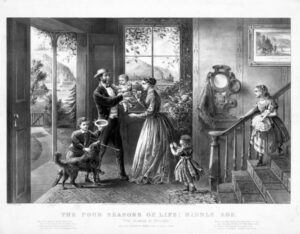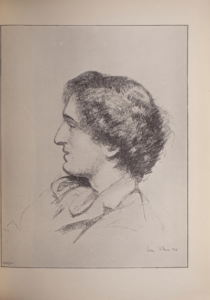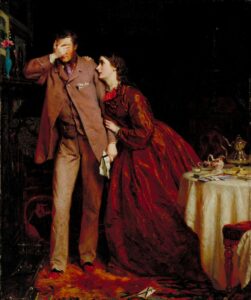Romantic Marriage and The Victorian Era in “Home…” by Richard Le Gallienne
© Copyright 2018 Nelli Khoudatov, Ryerson University

Introduction
The assumption that women during the Victorian Era carried the role of the caregiver for their children while men were providers for their families, implants the idea that women were oppressed, had little choice, and romance could therefore not situate in those circumstances. To the contrary, the Victorian Era was revolutionary for women’s roles in society and the norms shifted as they were joining the work force. Although the pressure to undertake the role of a mother was still a concept that had not faded, in fact was encouraged, women were motivated to pursue goals that fulfilled them in other areas. The link between women having more independence supports the notion that they could choose a spouse of their own volition.
I investigated what marriage consisted of during the Victorian Era, whether romantic or convenient was more prominent, the societal attitudes toward marriage, and how changes in women’s roles could have influenced circumstances of marriage. The inspiration of this investigation is from the poem “Home…” by Richard Le Gallienne in The Yellow Book. The Yellow Book was a magazine published during the 1890’s that had a political impact and displayed a stance on societal standards. “Home…” is the opening poem in the forth volume and sets a tone for the rest of the magazine. In “Home…” Gallienne writes from the perspective of someone who had suffered the tragic loss of their spouse. The narrator reflects on moments he shared with his late partner triggered by his observations of couples experiencing those same simple moments. The passion and sorrow displayed in the poem ignited the curiousity of how the weight of love would carry in choosing a spouse during the 1890’s. Following my research I discovered romantic marriage and courtship had a presence and value during the late Victorian era, which ignited a conversation, and display of the effects on society and literature thus explaining the vivid emotion present in “Home…” and other inclusions in The Yellow Book.
The Yellow Book
The Yellow Book was an artistic hardcover magazine featuring short stories, poems, and illustrations produced during the 1890s. There was a political influence and attitude toward the changes the Victorian’s were experiencing. The Yellow Book was a display of the interpretations of those changes and had an unapologetic approach to vocalize and exhibit the interpretations as described by Lorraine Janzen Kooistra and Dennis Denisoff from The Yellow Nineties Online, it was “an innovative periodical of art, literature, and design.”
Richard Le Gallienne and “Home…”

Richard Le Gallienne was a well-respected writer and editor largely focused on romantic poetry and prose. He had submissions in nine volumes of The Yellow Book employing similar themes of bereavement and depravity. Gallienne had been married three times, he produced two daughter’s from the first two wives, and as stated in his biography by Jason Boyd in The Yellow Nineties Online, his first wife died of typhoid fever and “was to have a lasting effect on the remainder of his life.” This is evident in “Home…” when the narrator is in obvious mourning and the final three lines are written
Each day I tread each empty haunted room,
And now and then a little baby cries,
Or laughs a lovely laughter worse to bear. (Gallienne, 11, vol.4)
One could argue the poem is autobiographical, lamenting the loss of his partner and the sound of his child’s laughter that would normally bring joy, is a painful reminder of what no longer is. The vivid descriptions of his distress
Yes ! we had once a heaven we called a home,
Its empty rooms still haunt me like thine eyes (Gallienne, 11, vol.4)
It is clear how affected the narrator is by this loss and what visibly represents a courtship, amplifies his agony.
The Victorian Era and Marriage
In Courtship and Marriage in Victorian England by Jennifer Phegly, she details the rise of companionate marriage during the Victorian era and how it “became the ideal, and love was seen as a crucial component of marriage”(2). With this ideation, the societal norms were not as progressive as the attitudes of the Victorian’s approach to marriage, as Phegly consequentially points out there were “pitfalls of marrying for love and expecting companionship in a society in which men and women were assigned very different roles within the family and society and were treated very differently under the law”(3). The new conception of courtship allowed for women to have more freedom and a voice when it came to their husband, and his authority could be challenged (9).
Talia Schaffer describes the accounts of marriage during the Victorian Era and its portrayal in fiction in her book Romance‘s Rival: Familiar Marriage in Victorian Fiction. Although the focus is on the literature that was produced, Schaffer provides historical references. Schaffer states that “historians of marriage agree that the great innovation of marriage of the late eighteenth and early nineteenth century was the rise of romantic marriage(77),” which is demonstrated in The Yellow Book.
Romance and The Yellow Book
Gallienne’s contribution to The Yellow Book was not the only one that carried the romantic theme. “The House of Shame” by H.B. Marriott Watson, a short story about a man who is unfaithful to his wife who expresses remorse, which then tragically ends with her death, because her heart essentially could not handle it. The man, Farrell, is met with heartache. This is an example of the realities of marriage in the Victorian Era where although love could be present, and women were gaining confidence in independence, many experienced volatile courtships. The devotion to a partner is still apparent as the Victorian Era held the family union to a high regard. The pressure to choose a spouse by the authority of one’s family may have diminished, but to remain in one insisted on loyalty and preserving the family unit. Divorce rates had declined in the late eighteenth century but legal separation increased (Anderson, 162). The courts had made it difficult to legally divorce a spouse, as societal norms were not as advanced as Victorian’s were becoming.
In Kate Krueger’s observation from her article “Evelyn Sharp’s Working Women and the Dilemma of Urban Romance” about Sharp’s “In Dull Brown,” from volume 8 of The Yellow Book she describes how being a working woman altered the motives of the character Jean after she met a man on the train. Women were divided, they were either a part of the workforce, or housewives. Krueger implies women struggled when they desired to employ both aspects into their lives. This addition in The Yellow Book showed that for women, with choice came dilemma. Jean’s desire for romance increases when she realizes that obtaining a romantic relationship while having a profession would come with difficulty.
The Yellow Book using uncensored perspectives on marriage in addition to the praise of love and its importance, shows the reader that in editorship they were aware of the varying scenario’s, but not dismissing how impactful love can be, or potentially destructive. The Yellow Book was recognizing that old conventions of marriage were not what Victorian’s were seeking.

Divorce and Separation during The Victorian Era
Separation was the preferred route for Victorian’s due to many reasons, fear of neighbourhood publicity, being disgraced by family, and facing obstacles within the court system (Anderson, 163). Women being present in the work force did not account for the many that were unemployed and dependent on their husband, alimony was crucial for these women, “accordingly, every wife who filed a petition for judicial separation could also file for interim alimony immediately the citation had been served on her husband and confidently expect to be allotted a fifth of the matrimonial income, net of certain
outgoings, as before (Anderson, 173),” therefore there was incentive if one chose to file for separation. Non-compatibility was becoming reason enough for societal standard’s in the late eighteen hundreds, with influence from the circulating journals and novels (Anderson, 200). The significance of compatibility and love in marriage was growing and submissions such as “Home…” by Gallienne in The Yellow Book emphasized it.
Conclusion
During the Victorian Era romantic marriage was sought for, and the lack of it motivated ending it. To gain such pleasure in marriage had importance due to the alternatives that were no longer acceptable, such as remaining in an unloved marriage, submitting to the pressures of family, or obligation from societal standards. The Yellow Book had a clear stance that romantic marriage was achievable, but not all marriages were successful. “Home…” was a key example of the loss of love that was cherished so deeply, leaves one in despair.
Works Cited
- Anderson, Olive. “State, Civil Society and Separation in Victorian Marriage.” Past & Present, vol. 163, 1999: pp. 161–201. JSTOR, JSTOR, www.jstor.org/stable/651172/.
- Currier & Ives. “The Four seasons of life: middle age “The season of strength” / / J.M. Ives, del. ; drawn by Parsons & Atwater. New York: Published by Currier & Ives. Photograph. Retrieved from the Library of Congress, www.loc.gov/item/92500887/.
-
Hicks, George E. “Woman’s Mission: Companion of Manhood.” 1840, http://www.tate.org.uk/art/artworks/hicks-womans-mission-companion-of-manhood-t00397
- Jason, Boyd. “Richard Le Gallienne.” The Yellow Nineties Online . Edited by Dennis Denisoff and Lorraine Janzen Kooistra. Ryerson University, 2013, http://1890s.ca/HTML.aspx?s=legallienne_bio.html/.
- Kooistra, Lorraine Janzen and Dennis Denisoff. “Introduction to the Yellow Nineties.” The Yellow Nineties Online . Edited by Dennis Denisoff and Lorraine Janzen Kooistra. Ryerson University, 2012, http://www.1890s.ca/HTML.aspx?s=Intro_Y90s.html/.
- Krueger, Kate. “EVELYN SHARP’S WORKING WOMEN AND THE DILEMMA OF URBAN ROMANCE.” Women’s Writing, vol. 19.4, Taylor & Francis Group, 2012: pp. 563-583.
- Le Gallienne, Richard. “Home….” The Yellow Book, vol. 4, 1895: pp. 11. The Yellow Nineties Online. Edited by Dennis Denisoff and Lorraine Janzen Kooistra. Ryerson University, 2011, www.1890s.ca/HTML.aspx?s=YBV4_legallienne_home.html/.
- Phegley, Jennifer. Courtship and Marriage in Victorian England. Praeger, 2012.
- Sickert, Walter. “Bodley Heads. No. I: Mr. Richard Le Gallienne.” The Yellow Book vol. 4, 1895: pp. 83. The Yellow Nineties Online. Edited by Dennis Denisoff and Lorraine Janzen Kooistra. Ryerson University, 2011, http://www.1890s.ca/HTML.aspx?s=YB4_sickert_gallienne.html/.
- Sharp, Evelyn. “In Dull Brown.” The Yellow Book, vol 8, 1896: pp. 181-200. The Yellow Nineties Online. Editted by Dennis Denisoff and Lorraine Janzen Kooistra. Ryerson University, 2012, http://1890s.ca/HTML.aspx?s=YBV8_sharp_dull.html/.
- Watson, H.B. Marriott [Henry Brereton]. “The House of Shame.” The Yellow Book, vol. 4,1895: pp. 53-79. The Yellow Nineties Online. Edited by Dennis Denisoff and Lorraine Janzen Kooistra. Ryerson University, 2011, http://www.1890s.ca/HTML.aspx?s=YBV4_watson_shame.html/.
Images in this online exhibit are either in the public domain or being used under fair dealing for the purpose of research and are provided solely for the purposes of research, private study, or education.
